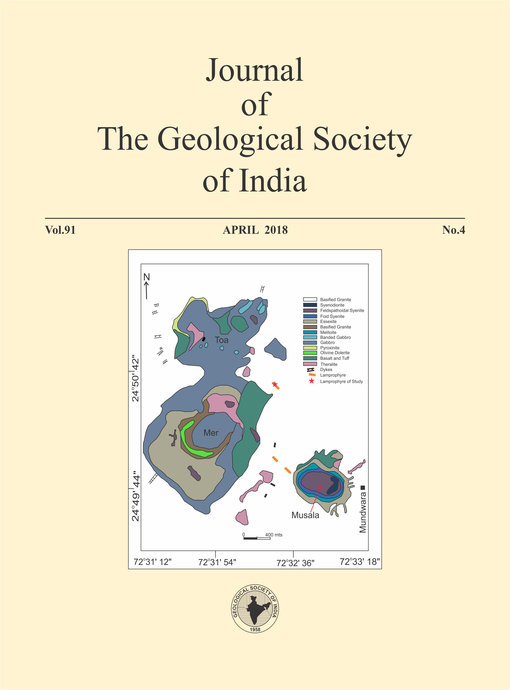Assessment of Potential Alkali Aggregate Reactivity for Siliceous and Carbonate Aggregates: A Case Study
DOI:
https://doi.org/10.1007/s12594-018-0880-3Abstract
Alkali-aggregate reactivity (AAR) involves a reaction between the pore solution of concrete and certain minerals found in some aggregates. To assess the potential AAR various physical and chemical tests are available and extensively used. The petrographic examination is the initial assessment that decides the further investigation for potential reactivity of an aggregate. A chemical approach is another option to assess the aggregate for potential AAR. The accelerated mortar bar method and concrete prism tests are other very important tests for determination of potential AAR of aggregates samples. However, a combination of the results of all the techniques provides most reliable results for potential AAR in aggregates. Moreover, each test represents the stepwise investigation and provides the decision for the test of next approach. Petrographic examination and chemical test methods are the quick decision-making methods for the estimation of potential AAR. In some cases, by these two methods, the aggregate can be selected and rejected confidently. However, for critical values or doubtful aggregates, further tests are necessary to develop a higher confidence level of the results. The present study comprises of the assessment of the alkali-reactivity of siliceous and carbonate aggregates using petrographic and chemical approaches. X-ray diffraction analysis was used as a complementary method to the petrographic evaluation. Moreover, under chemical approach, two separate test methods were used for siliceous and carbonate aggregates. The study also included a comparison between the petrographic examination and chemical analysis for the same aggregate samples and found significant results.Downloads
Metrics
Issue
Section
Downloads
Published
How to Cite
References
Ahmad, M., Ansari, M.K., Singh, R., Sharma, L.K., Singh, T.N. (2017a) Assessment of Durability and Weathering State of Some Igneous and Metamorphic Rocks Using Micropetrographic Index and Rock Durability Indicators: A Case Study. Geotech. Geol. Engg., v.35(2), pp.27-842.
Ahmad, M., Ansari, M.K., Singh, R., Sharma, L.K., Singh, T.N. (2017) Estimation of Petrographic Factors of Deccan basalt using petro-physicomechanical properties. Bull. Engg. Geol. Environ., doi: 10.1007/s10064017-1061-0
ASTM C295 (2012) Standard Guide for Petrographic Examination of Aggregates for Concrete, ASTM International, West Conshohocken, PA.
CAN/CSA-A23.2-26A (2014) Determination of Potential Alkali-Carbonate Reactivity of Quarried Carbonate Rocks by Chemical Composition
Concrete Society (1987) Changes in the properties of ordinary Portland cement and their effects on concrete. Concrete Society Technical Report, London: Concrete Society 29.
Dolar, L.M. (1983) Handbook of concrete aggregates, a petrographic and technological evaluation: Park Ridge, N. J. Noyes Publications pp.345.
Dunkan, M.A.G., Swenson, E.G., Gillott, J.E., Foran, M.R. (1973) Alkali aggregate reaction in Nova Scotia I. Summary of a five – year study, Cem. Concr. Res., v.3, pp.55–69.
Gillott, J.E. (1964) Mechanism and kinetic of expansion in the alkali-carbonate rock reaction, Canadian Jour. Earth Sci., v.1, pp.121-145.
Gillott, J.E., Swenson, E.G. (1969) Mechanism of the alkali-carbonate rock reaction, Jour. Engg. Geol., v.2, pp.7-23.
Góralczyk, S. (2012) Alkali-carbonate reaction of aggregates. Gospodarka Surowcami Mineralnymi, v.28, pp.45-62.
Hadley, D.W. (1961) Alkali reactivity of carbonate rocks-expansion and dedolomitization, Proceedings Highway Research Board, Washington, DC, v.40, pp.462-474.
Hobbs, D.W. (1989) Effect of mineral and chemical admixtures on alkaliaggregate reaction, Eighth International Conference on Alkali-Aggregate Reaction, British Cement Association,Wexham Springs, Slough, UK.
IS 2386-VII (1963) Methods of test for aggregates for concrete, alkali aggregate reactivity, Bureau of Indian Standard, New Delhi
IS 2386-VIII (1963) Methods of test for aggregates for concrete. Petrographic Examination. Bureau of Indian Standard, New Delhi.
IS 4032 (1985) Method of chemical analysis of hydraulic cement. Bureau of Indian Standard, New Delhi
Jensen, V. (2012) The controversy of alkali carbonate reaction: state of art on the reaction mechanism, Proc. 14th Int. Conf. AAR, Texas, USA.
Katayama, T. (2004) How to identify carbonate rock reaction in concrete, Materials Characterization, An International Journal on Materials Structure and Behaviour (Ed. Chris Bagnall), Elsevier publication, v.53, pp.85-104.
Katayama, T. (2010) The so called alkali-carbonate reaction (ACR)-Its mineralogical and geochemical details, with special reference to ASR, Cement and Concrete Research v.40(4), pp.643-675.
Mather, K. and Mather, B. (1991) Aggregates in Kiersch, G.A., ed., The heritage of engineering geology; The first hundred years, Centennial Special. Geol. Soc. Amer., Boulder, CO, v.3, pp.323-332.
Mielenz, R.C. (1978) Petrographic examination (Mineral aggregates), ASTM STP 169B, pp.539-572.
NRMCA (1993) Guide specifications for concrete subject to alkali-silica reactions, Mid-Atlantic Regional Technical Committee, (Available through NRMCA, Silver Spring, Maryland).
Ozol, M.A. (1994) Alkali-carbonate reaction, ASTM STP 169C: pp.327-387.
Ramos, V., Farnandes, I., Silva, S., Soares, D., Noronha, F. (2016) Potential reactivity of granitic rocks. Petrographic characterization vs accelerated expansion tests, Revista IBRACON de Estruturas e Materiais. Doi: http:/ /dx.doi.org/10.1590/S1983-41952016000100005.
Rogers, C.A. (1986) Evaluation of the potential for expansion and cracking of concrete caused by the alkali-carbonate reaction, Cement, Concrete, and Aggregates, CCAGDP, 8(1): 13-23.
Singh, R., Umrao, R.K., Ahmad, M., Ansari, M.K., Sharma, L.K., Singh, T.N. (2017) Prediction of geomechanical parameters using soft computing and multiple regression approach. Measurement, v.99, pp.108-119.
SWENSON, E.G. (1957) A reactive aggregates undetected by ASTM test, ASTM Bulletin, Amer. Soc. Testing Materials, v.226, pp.48-51.
Tang, M., Deng, M., Lon X., Han, S. (1994) Studies on alkali-carbonate reaction, ACI Materials Journal, American Concrete Institute, Farmington Hills, Michigan, pp.26-29.
Tang M, Deng M (2004) Progress on the studies of alkali-carbonate reaction, Proc. 12th Int. Conf. AAR, Beijing, China: 51-59.
Thomas, M.D.A., Fournier, B., Folliard, K.J. (2008) Report on determining the reactivity of concrete aggregates and selecting appropriate measures for preventing deleterious expansion in new Concrete Construction.
Tong, L. (1994) Alkali-carbonate rock reaction, Doctor Thesis, Nanjing Institute of Chemical Technology, Nanjing China: 219 p.
Xu, H. (1987) On the alkali content of cement in AAR in concrete alkali aggregate reactions, Proceedings of the 7th International Conference, (ed. Grattan-Bellew, Patrick, E.), Noyes Publications, Park Ridge, New Jersey, pp.451-455.

 M. Ahmad
M. Ahmad






